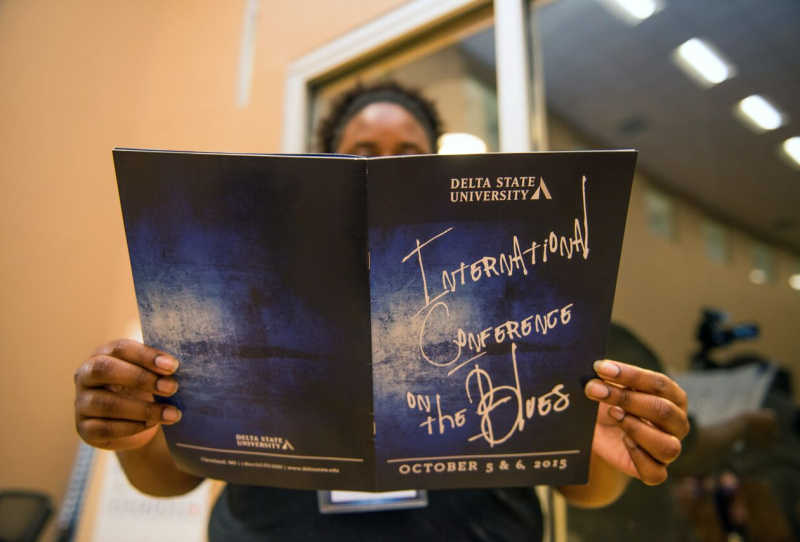
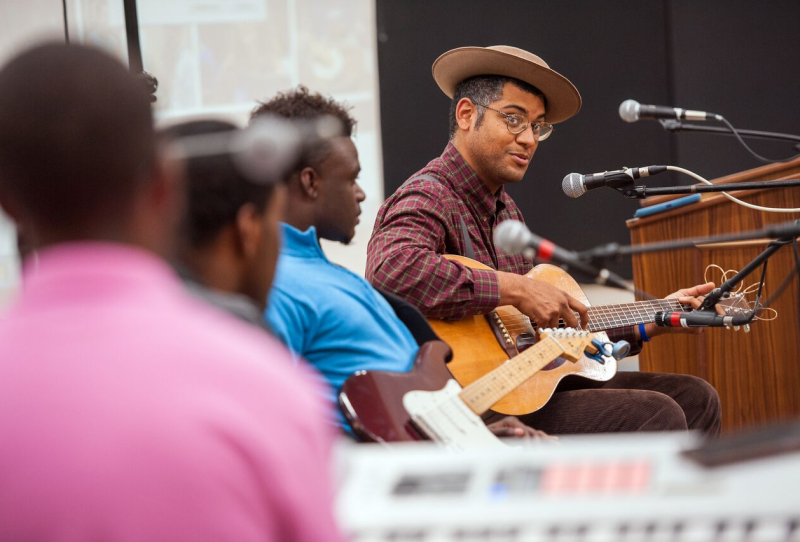
In addition to being a GRAMMY winner, Dom Flemons is a walking university of not only the blues tradition, but the American music tradition. I’ll just read the assortment of instruments to which he’s an expert: everything from the banjo, guitar, harmonica, fife, the bones, the bass drum, the snare drum, and the quills—in addition to singing, he’s played from every venue from Bonnaroo in Manchester, Tennessee, to The Grand Ole Opry in Nashville, Tennessee. He truly is an American musician. In particular, he uses the title “American Songster,” which we will get to, here in a minute. But I’d like to start off with an easy question - what did you do with your GRAMMY Award?
Well, I got the Grammy in 2011. We got nominated in 2010. It was just sitting in my house and I was really enjoying it. It’s really something to have one of those things on your mantle at home. For the past several years, since about 2006, I’ve worked with a non-profit organization called Music Maker Relief Foundation. And of course, they put out the first four albums of the Carolina Chocolate Drops, which was my previous group. Tim Duffy, the founder, asked me if I wanted to include my GRAMMY in the traveling exhibition for the We are the Music Makers Exhibition, featuring photos of a lot of the Music Maker artists. And I said, “Sure.”
It just sits in the house. So I said, “Well, man, get it in a museum and be able to have it travel all over the country and all over the world? Yeah, that sounds great.” So I got to see it in Shelby, North Carolina at the Earl Scruggs Center over there, and they did a good job shining it up and making it look really nice. So that’s where my Grammy is right now, traveling: it’s on tour [laughter].
Perpetually on tour, like you are.
Oh yes. Oh yes.
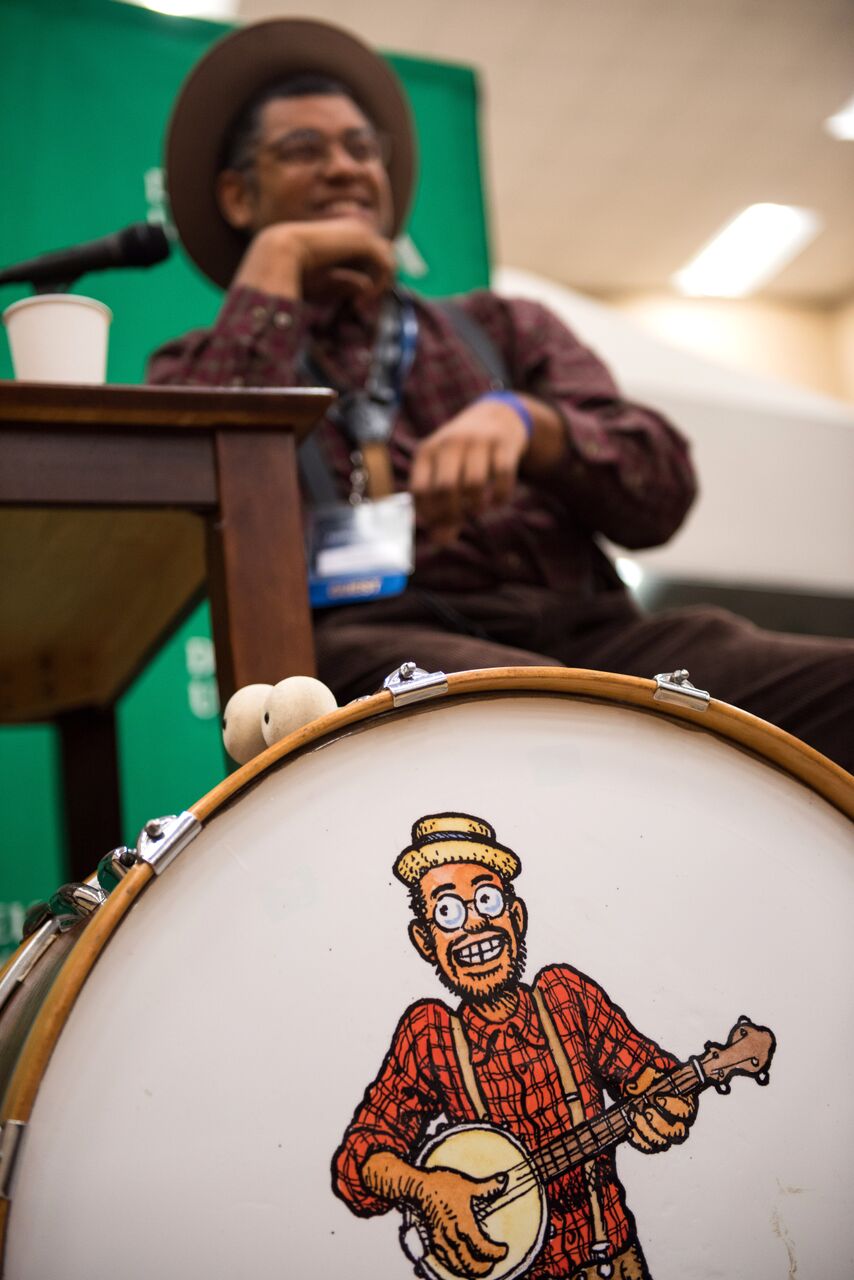
Now we’re going to go way back to the late 1990s when you were in high school in Phoenix, Arizona. Many of our students here at Delta State University get their first initial music training through high school and junior high school music programs through marching band, and you shared that route. Can you tell us a little bit about your career as a high school marching band percussionist, and how it started your love of traditional American music?
Sure thing. I started in the band when I was in fifth grade. And like anybody else, I just started playing the drums. That was what interested me the most. I played a lot of different percussion instruments, I played the cymbals, the snare drum, and I played the concert bass drum and the timpani. And again in hindsight, thinking back on it, I’m really glad that I had that training because now music education is not treated as important as it was when I was coming up. It was good to have gotten that exposure, because I learned to appreciate music. And then when I got into high school, the option for marching band came up and I played over my high school years, four different drums. I played the small drum, the slightly bigger drums, and then got to the drum about this big by my senior year. And so we used to do—we used to just do cadence songs. We used to just do stuff like that as we marched down the fields, and then when we would be in the stands during the football games. So in Central High School in Phoenix, we weren’t a good team, haha.
It was my senior year toward the second to last game, that we scored our first touchdown. So the band had a lot of fun coming up with a lot of different riffs and different songs that we would play in the stands, so I got a lot of great experience with that. And see, that linked into the first time I went to college at Northern Arizona University.
See, I wanted to be a folk singer; that’s what I wanted to be first.
In the LP library, when I was at College, they had a record called The Roots of the Blues, put out by New World Records, and it was put together by Alan Lomax. And it featured a great recording of two men, Ed and Lonnie Young, and they featured a song called “Jim and John.” So up to that point, I’d been, [drums music], that beat. But when I heard them, I heard, [drums music]. That was a funky beat there and so that drew me in as a drummer, and to hear the fife on top. Playing some of those fife and drum songs, it made me want to get deeper into the traditional music, just on my own and as a drummer.
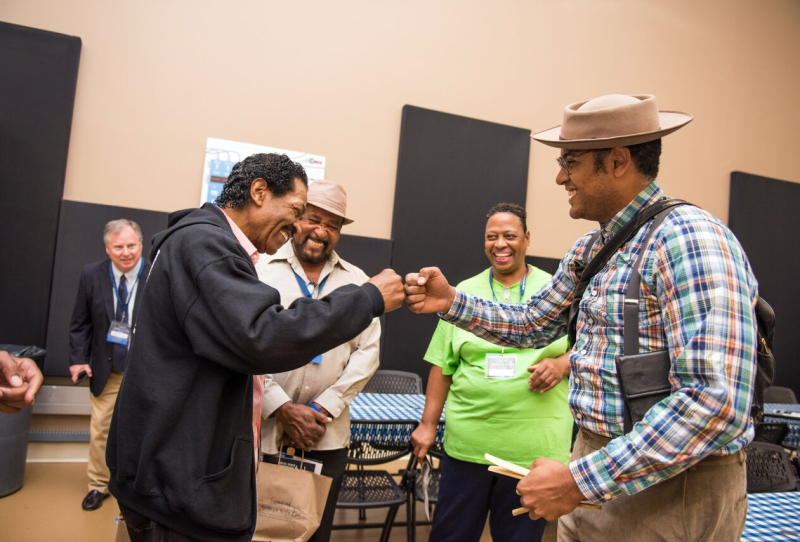
Rory Doyle/Delta State University
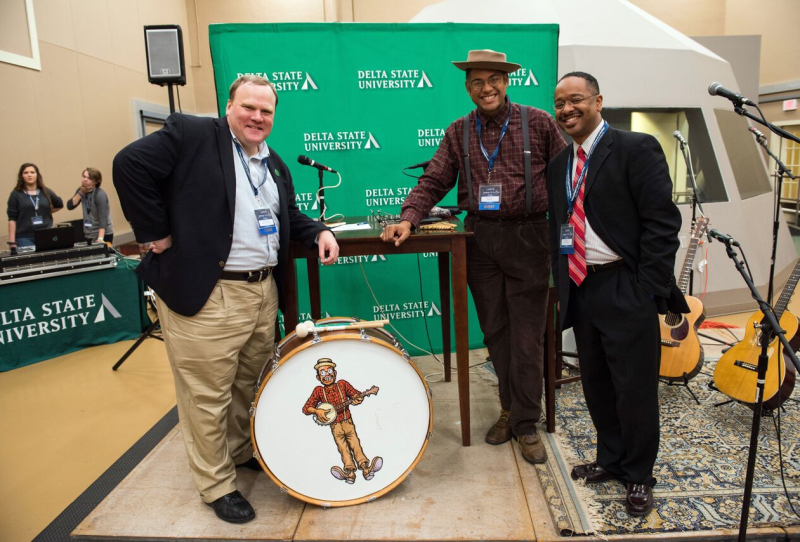
Rory Doyle/Delta State University
Another great term from this era of American music: I want you to define for the audience. This is your title, “The American Songster.” Tell us about the songster tradition.
Well, when I first started getting into the blues—country blues—there were these musicians called Songsters that would show up in books. In a lot of the blues books, they would be like the early version or prototype blues singers. I loved their songs a lot. They were people like Henry Thomas; there was Papa Charlie Jackson; Jim Jackson, who was from North Mississippi. And then there’s a whole bunch of the guys from North Mississippi coming up to Memphis that were songsters as well - Jim Jackson, Robert Wilkins, Gus Cannon, just a whole slew of those guys, Joe Callicott, all those guys. And they played folk songs, like a bigger folk style. And of course, Lead Belly is probably the most well-known of the songsters. But he comes from a different spot, where he wasn’t making straight commercial recordings; he was making field recordings for the Library of Congress. This, again, is a whole other way that the music branches off into its own story. And so I started hearing these guys and I just loved their songs, and I just kept playing them. Gus Cannon, for example. He was one of the few blues banjo guys to record in the ‘20s, and I loved his songs and wanted to learn them, and I just felt a connection to that. See, I wanted to be a folk singer; that’s what I wanted to be first. But see, at that time, folk was a four-letter word, as it is now, and you couldn’t really book gigs in a real way, as a folk singer, by that point. Folk music had a great resurgence in the early ‘60s, going to the early ‘70s. But commercially, the folk music has merged with singer/songwriters genre and it just hasn’t really been reexamined since. Except for now, which is cool, seeing some of those people coming back again, some of those styles.
Styles changed, but the ideas and the memories of what that banjo represents and what it means, stayed.
But I decided on being a songster, because I thought it was great. Paul Oliver, from England, had a great definition for it.
A songster was a musician in the community that sang and played songs. And see, I can do stuff instrumentally, but I’ve always sang and played. So I thought that was perfect, and it really let me be able to get out of the box of just saying I’m a folk singer, or a blues singer, or rock singer, or R&B singer, or any of that stuff; I could just say I’m a songster, and that I focus on American music more than any type of music. So another point, my second solo record was called American Songster, and I realize that that’s an excellent moniker to have on there. So I made it “American Songster.” And I ran into another friend of mine, Ian Thomas; at the time, I had a tintype photo that said, “American Songster.” I went to this gig, and then Ian had a tintype photo and it said “American Songster” on there. So I changed it to “THE American Songster,” just so people knew the difference.
So, there’s been a lot of different history that’s happened with the banjo over time. You have first, of course, the folks who brought it over from the Old World and brought it to the New World. Then it changed hands after about a hundred years, and it mixed in with the mainstream culture and white culture, and there was a lot of appropriation that happened within that, when it became a popular instrument. But there was always a lasting folk tradition that was in the black and white communities, and that kept on until 1880s, or something like that. It had a very strong tradition, and then, new styles of music came along, as popular music began to flourish in America. Styles changed, but the ideas and the memories of what that banjo represents and what it means, stayed.
And this leads into the next question. When I teach about the blues, it’s tough for me to talk about the blackface minstrel tradition. Can you tell us the connections to the banjo and in general the connections to American music, given that it is not always a comfortable topic to address?
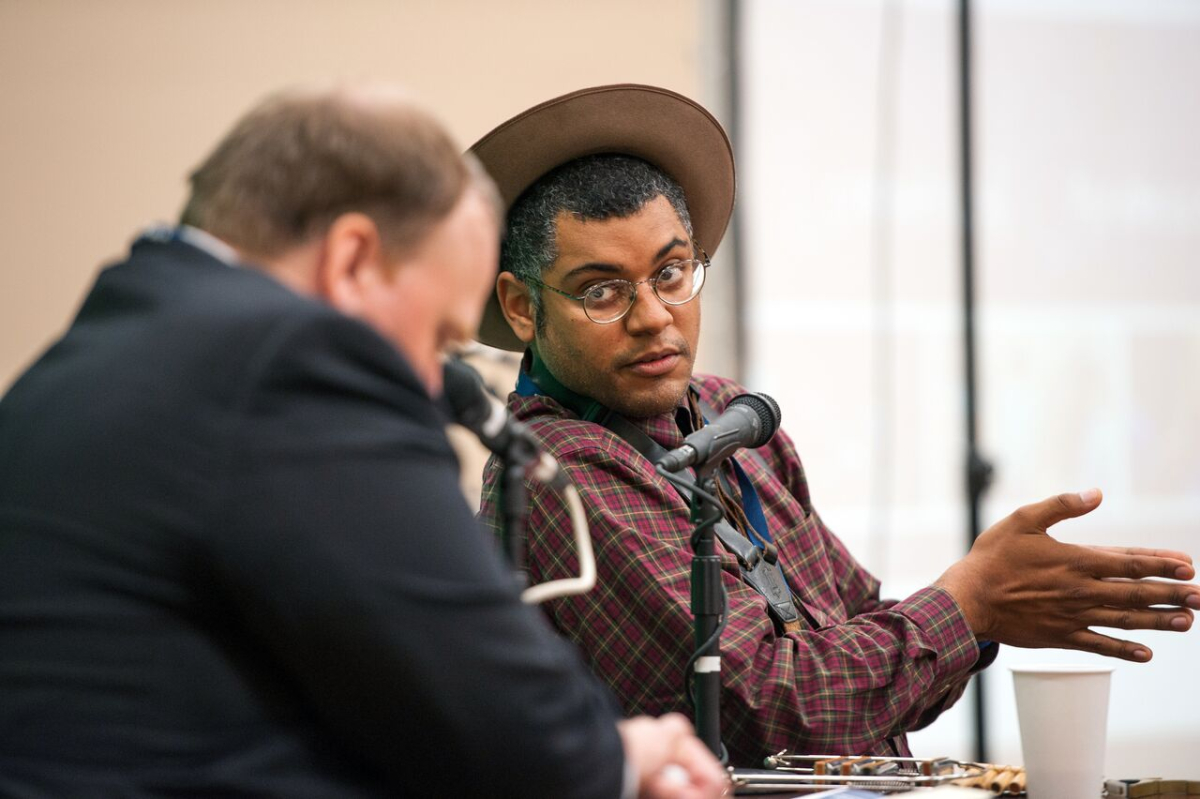
Well, if you break music down—if you think of it as three strains, that’s how I’ve thought about it: you have popular music. So music that’s popular in whatever form it may be, but popular: everybody hears it, it’s on the stage, and it’s removed. Then you have folk music: there’s a repertoire of folk music, but it’s songs that come from the people, and it’s not on the popular stage. And then the third strain, at the bottom, is just what folks play. That can mean anything. There’s no rhyme or reason, just because we’re all human beings, there is no rhyme or reason to why we like things. We just like things, and so that’s a thing to think about when you think of the blackface minstrel show.
When I started really studying that part of the history, I started finding weird contradictions; for instance, I started seeing pictures of black blackface minstrels. When I’d read it in a book, it’d say it was white guys blacking up and making fun of black people, but then, I’d see black people doing it. So I started wondering, “What does that mean?” If it’s such a denigrating form, why would that be a part of black culture as well? But of course, the history’s complex. After the Civil War, the blackface minstrel show became such a popular form of entertainment in America. It was the first time that America was able to really break away from English musical traditions, with “common man music.” First time ever.
And so it got so big, that it was the only way to be able to really get into the entertainment business, and so there was a generation that had to choose, “Okay, I’m getting into the business. So in getting into the business, I have to get into the theater.” And the theater had certain characters, certain ideas, certain sketches, and certain pieces of the theater. Like, if you think of a play, you have characters that you have to do, in a certain way, or else it’s not the same. And so that’s what one generation had to do.
I think an atlas from the 1880s or 1870s that mentioned Avalon, Mississippi. And so he just got in a VW Bug and just drove down, and went down and recorded Mississippi John Hurt.
But with each succeeding generation, you had people with different ideas that were trying to move away from the blackface minstrel show. You had other people that were adapting the blackface mask for it to mean something else. So when we talk about the blues, the blues came from two different things. There’s the folk tradition of the blues, which is something that grew under the radar with the people, and it was played in the levee camps and the lowdown juke joints and all that stuff. But then you have the popular blues, which was the way that America was introduced to the blues, which was through—it wasn’t exactly through the blackface minstrel show; it’s like three steps removed from that. Because a lot of times, we talk about the blackface minstrel show in the antebellum era before the end of the civil war, back in the 1840s and 1850s. But it’s like when you get to the 1890s, you have a totally different beast happening. And so, the first published blues: WC Handy published the “Memphis Blues,” and there were other people that were publishing blues as well that had links into this older black vaudevillian—by that time they called it black vaudeville performance style. And you also had these tent shows that would go around.
So in the South, the minstrel show was still was very popular in the 1890s. But you had these tent shows that were almost like black circus shows. So it’s like they were circus performers, opera singers, blues, jazz, all sorts of stuff, and they would hole up in one of the off-towns. So if you can imagine, like Clarksdale, Mississippi, for example. Go 30 miles west of Clarksdale, set up your big tent knowing that all the country people would come to this thing. That was one of the ways that the blues came into it. That’s where Ma Rainey, Big Joe Williams, the Rabbit’s Foot Minstrels are probably the most famous, and they were based out of the Deep South. And so that’s where you start having the blues. So the blackface minstrel show, it’s pretty far removed in one way, but it really demonstrates where the popular blues - compared to the folk blues - came from. You have to understand where all this early minstrel show stuff started, and then you have several generations that make the choices of, “This is what I want to do with the style. This is what happens in this side of the style and all that.”

Songster is so much a cooler word than saying he’s a "multi-instrumentalist." But back to the multi-instruments, in addition to the banjo, which I think you’re going to demonstrate a little bit, talk about how you convert banjo music to guitar and vice versa. Last night, we started talking about some of the other instruments in your repertoire, in particular the bones and the quills. And you told me how you got the quills; you got a guy in Santa Rosa, California that Mike Seeger recommended.
And there are three quills players that recorded, so I learned all three of those styles. Of course, to start with Mississippi, you’ve got Sid Hemphill. He played the fiddle and the quills, and the fife. And I learned his song Devil’s Dream, which is—it’s interesting getting into old timey music. He does this very interesting harmonic change to it. So you have the song: [plays music]. That’s the regular “Devil’s Dream,” but Sid Hemphill hoots the melody and then uses the quill under it.
Sid Hemphill hoots the melody and then uses the quill
I’m going up the country. When do you want to go? Haha, all right. So I told you last night, I was going to give you a list of Mississippians, off of which to riff. Groups and artists that have inspired you, who you’ve found musically interesting. So let’s start with one of the giants of this area: Charley Patton.
I’ve always loved his music. Funny enough though, the songs that always interested me were songs like “Shake it and Break it” like this: [plays Patton music riff]. And another thing that drew me to a lot of folk music, I really liked the way that people’s voices sounded different. So one of the things in my act, see, is that I’m a vocal contortionist. So I tend to do different vocal styles for each song, based on whatever it is. Sometimes it’s based on the original, other times it’s something I just make up that’s a composite.
But another Mississippian from Avalon. Mississippi John Hurt.
Yeah, one of the greats. He’s one of the guys that really got me into finger picking. Between him and Elizabeth Cotten from Carrboro, North Carolina. Those are my two main people that I listen to, to just get into finger picking. This is the first song I ever heard from Mississippi John Hurt. Because he recorded it in the 1920s, and then he was again recorded—that’s a really interesting story, if you look into Tom Hoskins and Dick Waterman and the whole story of Mississippi John Hurt’s rediscovery. But these guys from the Washington, DC area, for the most part, they came down and they—well see, “Fang” was a weird proto-hippie, I guess you’d call it, but he was an out-there guy. And he was having a drug-induced dream about Mississippi John Hurt and a song called Avalon Blues, where John talks about “Avalon’s my hometown, it’s always on my mind. Avalon’s my hometown, always on my mind.” So he got obsessed with trying to find where this place Avalon was.
And so he saw “Mississippi” and the “John Hurt” on the title of the record. And so he said, “Well, is there an Avalon, Mississippi?” And he kept looking through these atlases, until I think he found something, I think an atlas from the 1880s or 1870s that mentioned Avalon, Mississippi. And so he just got in a VW Bug and just drove down, and went down and recorded Mississippi John Hurt. He went to the post office and said, “Do you know who Mississippi John Hurt is?” And the guy is like, “Yeah, just go around the road here, he just lives down the way.” And of course, John being an older Southern black man in the early 1960s; he’s suspicious of a young white guy with long hair who comes down and starts asking him questions about his music. And so he thinks he’s a guy from the government; he doesn’t know what he’s up to. So he just plays it cool and plays a couple of songs for him, and that becomes his discovery in the folk revival; he influenced a ton of people.
But on Vanguard Records, a great folk singer, Pat Sky, supervised a session with John. Everybody was ogling over John so much, that Pat said, “Everybody get out of here,” and he grabbed a little bottle of something and he and John had a nice quiet session. And the first song on that record is one called “Payday.” [plays music] “Here’s a deed all I can do and I can’t get along with you, I’m going to take you to your mama, payday, payday, payday. Well, there’s a rabbit in the log. I ain’t got no rabbit dog, and I hate to see my rabbit get way. Get away. Get away. I hate to see my rabbit get away.” It was really wonderful to hear John Hurt; in a way, he has such a mellow and soft style. A lot of the Mississippi Blues that were recorded, have a lot more of a heavy or emotional type of singing style. Like you think of someone like Son House, for example.
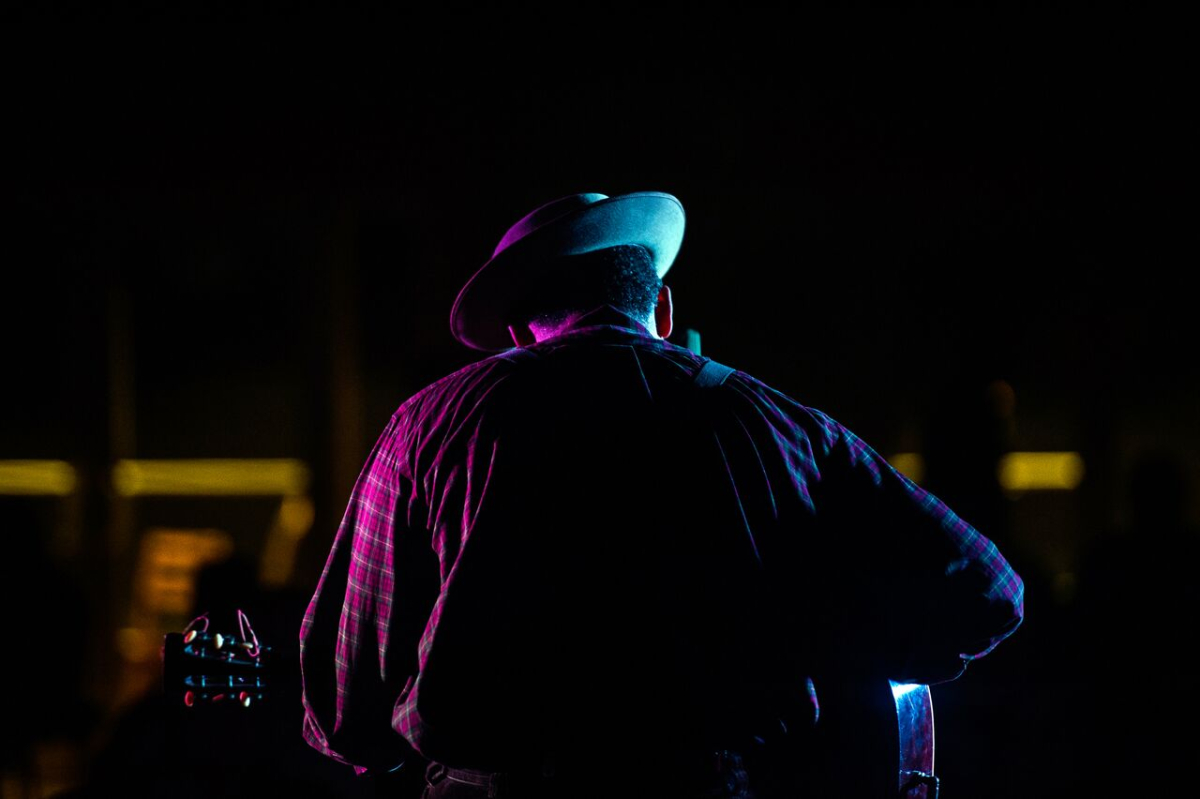
And that ties to my final Mississippian, because we’re about to change over sessions. Speaking of a heavy sound, Howlin’ Wolf. You’ve mentioned him a couple of times, in interviews. How did he pique your interest with that Chicago sound?
Well, the first time I ever saw a video of Howlin’—see, I listened to his recordings and they were really amazing. I was more into country blues though, but when I saw a video of Howlin’ Wolf singing. He was singing “Shake For Me.” Man, what a power and a presence.
And also always in this three-piece suit sweating it up, and just doing the right stuff. And again, for unique voices, when you hear: “Now if you hear me howlin’, callin’ on my darlin’. Oh, oh yeah.” And he had a whole bunch of particular, idiosyncratic things he would do, “She’s hot like red pepper!” and just get a little extra little wiggle in the head movement. And just a lot of jive in his style as well. I understood Sam Phillips’ quote about him. Because even though he’s most famous for discovering Elvis and Johnny Cash and a slew of other people at Sun Records, Sam Phillips always said that Howlin’ Wolf was his main discovery: He said, “That big man would sit down with that harmonica and that vein would get popping out of his head; he’d start tapping his foot, and I knew that was where the soul of man never dies.” And that’s a powerful thing. And when you see a video of him, or you hear the song that Sam recorded, Moanin’ At Midnight, with the “Mm-hmm.” Just getting to that moan and that howl, that’s some deep stuff.
Just as both Sam Phillips and Howlin’ Wolf had powerful stage presences, you do, too. Ladies and gentlemen, let’s give Dom Flemons a big round of applause.
Oh, thank you.

